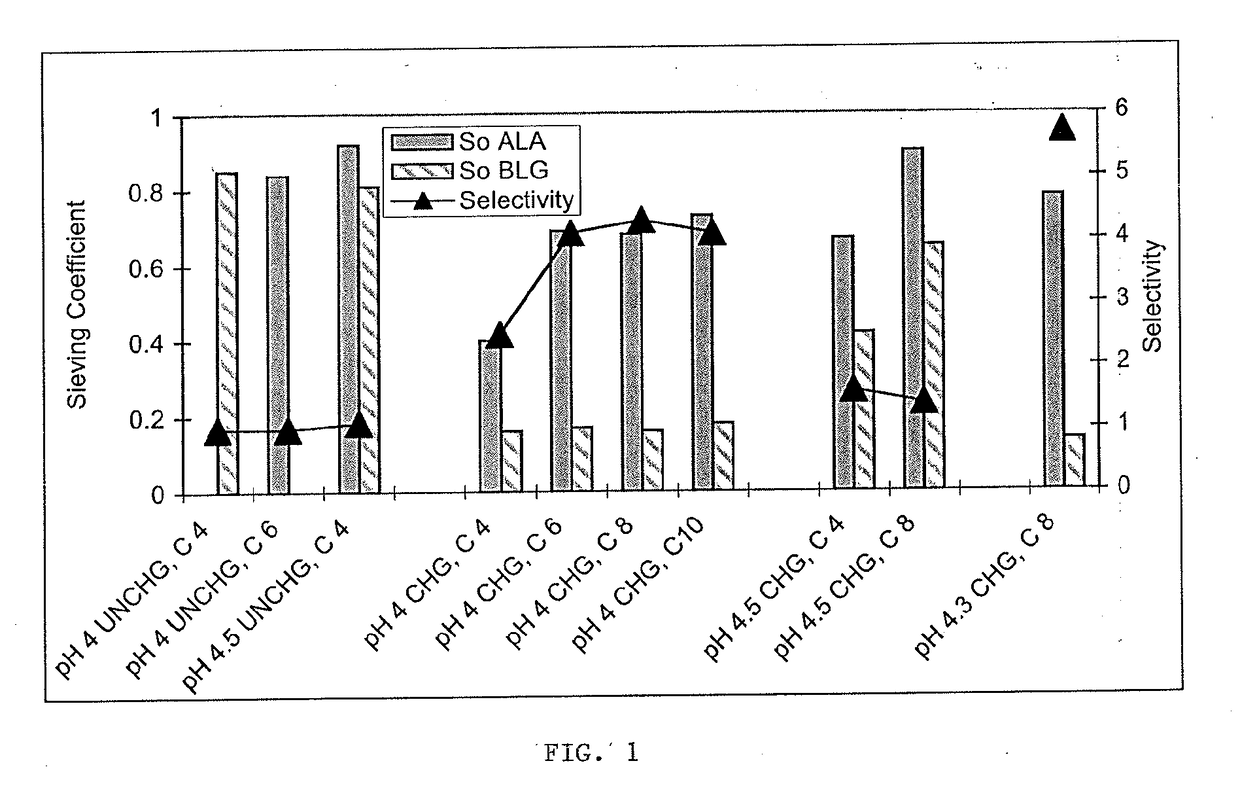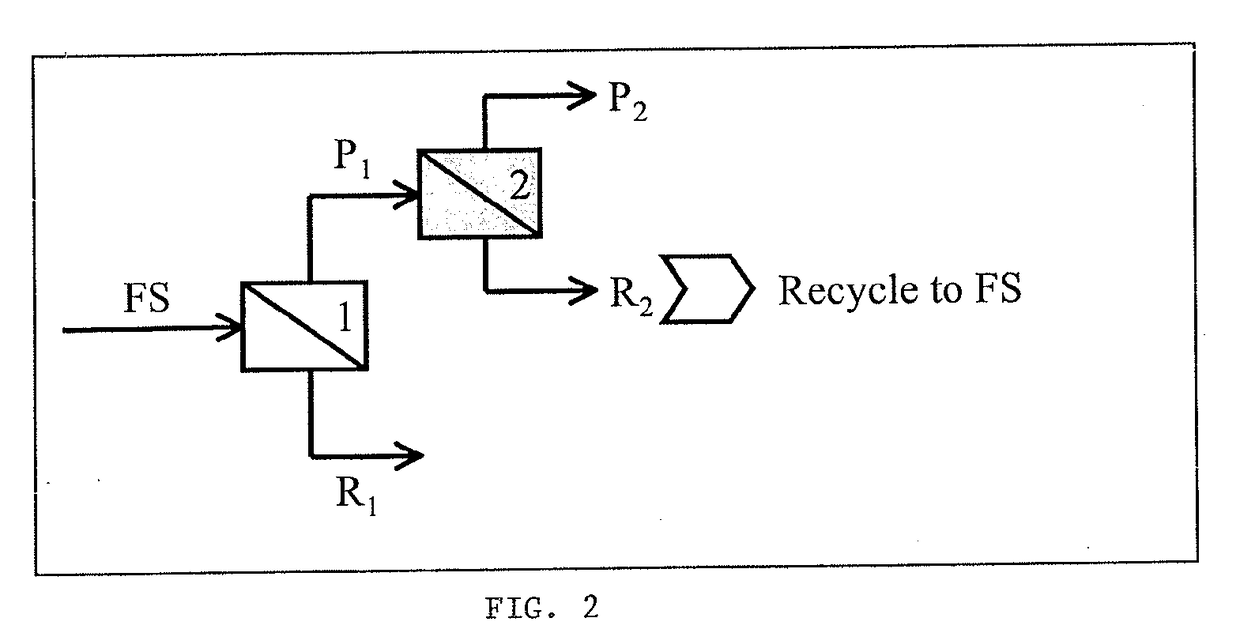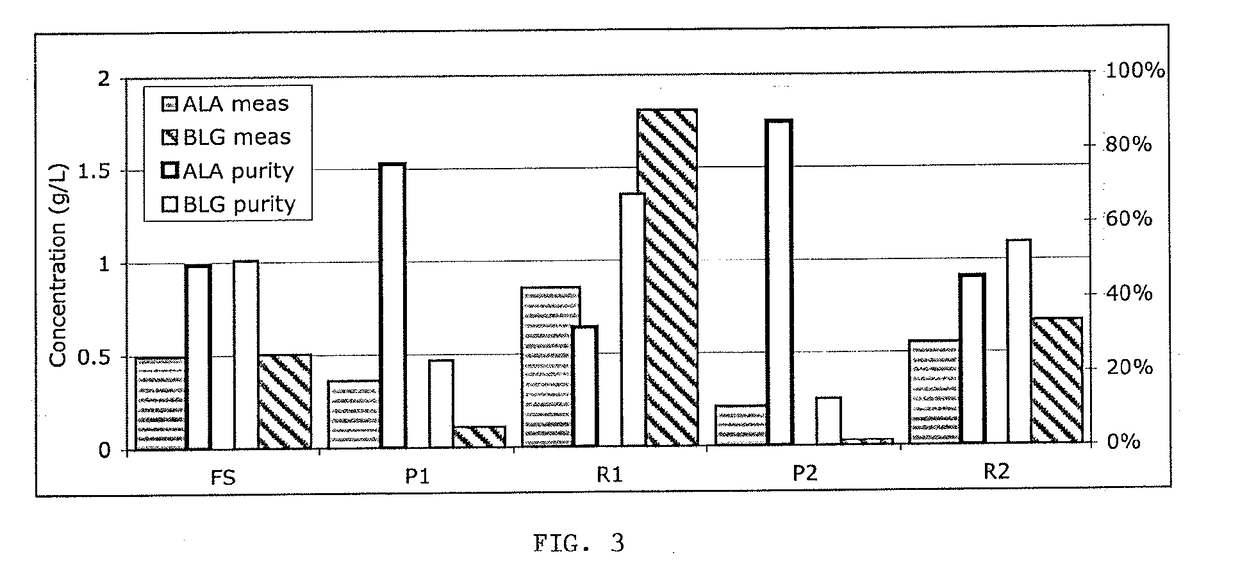Methods and compositions involving whey protein isolates
a technology of whey protein and composition, applied in the field of methods, can solve the problems of slow adoption of chromatography, low efficiency of chromatography, and insufficient separation of whey protein isolates, etc., and achieve the effect of improving the efficiency of chromatography, and reducing the cost of chromatography
- Summary
- Abstract
- Description
- Claims
- Application Information
AI Technical Summary
Benefits of technology
Problems solved by technology
Method used
Image
Examples
example 1
[0058]A 300 kDa cross-flow ultrafiltration membrane (50 cm2 regenerated cellulose membrane, Pellicon XL, Millipore, Bedford, Mass., USA) was used to separate alpha-lactalbumin (ALA) and beta-lactoglobulin (BLG) to illustrate the effect of membrane charge, and solution pH and conductivity on the observed sieving coefficient (So) and selectivity of the separation (FIG. 1). An uncharged 300 kDa ultrafiltration membrane should not retain ALA (14.4 kDa) and BLG (18.6 kDa) because both proteins are at least ten times smaller than the rated membrane pore size. As expected, this is what was observed. Most of the ALA and BLG freely passed through the uncharged membrane, with only about 8 to 16% of the ALA and 15 to 19% of the BLG retained at pH 4.0 to 4.5 and conductivity 4 to 6 mS / cm (So ALA≈0.88, So BLG≈0.83). Selectivity of the separation is defined as the ratio of the sieving coefficients and no separation occurs for a selectivity of one. The selectivity of the uncharged ultrafiltration ...
example 2
[0062]The conditions of Example 1 can be used on a feed stream (FS) to make a first permeate stream (P1) enriched in the protein of interest (ALA) and a first retentate stream (R1) enriched in the other species (BLG). As shown in FIG. 2, a second charged ultrafiltration membrane can be used on the first retentate stream to make a second permeate stream (P2) and a second retentate stream (R2). This staging of the charged ultrafiltration membranes has the advantage of increasing purity and offering the opportunity to recycle intermediate streams to the feed stream (FS) to reduce waste.
[0063]For example, a feed stream containing 0.5 g / L each of ALA and BLG was adjusted to pH 4.3, conductivity 8 mS / cm and fed to a 300 kDa charged ultrafiltration membrane (FIG. 3). The feed stream had 50% purity each for ALA and BLG. The first permeate stream (P1) was higher in ALA purity (77%) and the first retentate stream (R1) was higher in BLG purity (68%) than the feed stream (FS). The first permeat...
example 3
[0065]Milk serum protein (MSP) was fractionated using a charged 300 kDa ultrafiltration membrane. Skim milk was subjected to microfiltration to remove caseins and residual lipids, and form the MSP solution. The MSP solution was adjusted to pH 4.3 without adjustment of the conductivity. The natural conductivity of the MSP solution was about 8-10 mS / cm. It was desired to fractionate the MSP at this natural conductivity without the use of either electrodialysis, diafiltration, dilution by addition of de-ionized water or other methods to lower the conductivity. Using the MSP at the natural conductivity is less expensive than the use of any of the preceding methods. It was also desired to avoid the dissolution of dried MSP in buffer to eliminate the expensive steps of concentration and drying of the MSP, and the expense of addition and then disposal of the buffer salts. By using the natural MSP solution that was made directly from the microfiltration of skim milk, the cost of manufacture...
PUM
 Login to View More
Login to View More Abstract
Description
Claims
Application Information
 Login to View More
Login to View More - R&D
- Intellectual Property
- Life Sciences
- Materials
- Tech Scout
- Unparalleled Data Quality
- Higher Quality Content
- 60% Fewer Hallucinations
Browse by: Latest US Patents, China's latest patents, Technical Efficacy Thesaurus, Application Domain, Technology Topic, Popular Technical Reports.
© 2025 PatSnap. All rights reserved.Legal|Privacy policy|Modern Slavery Act Transparency Statement|Sitemap|About US| Contact US: help@patsnap.com



